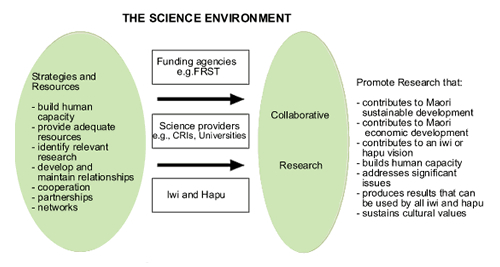Encouraging collaboration

Image - Adrienne Farr
Identifying future opportunities for collaborative research with iwi and hapu requires an understanding of future research needs by various Mäori organisations, and identification of the strategic research areas in which collaborative research should be promoted. Creating the right science environment in which collaborative research with iwi and hapu can occur is extremely important (Figure 1).
A number of issues and comments about what constitutes research relevant to Mäori have repeatedly been raised in hui, and in iwi and hapu research project discussions throughout the country during the last 10 years. In summary, Mäori are very supportive of research that:
- directly contributes to Mäori sustainable development, taking into account cultural, social, environmental and economic outcomes;
- directly contributes to economic development that fits an iwi or hapu vision;
- helps to address and find solutions to major iwi or hapu issues;
- is generic, and where results can be applied to other iwi and hapu;
- provides iwi and hapu with a means to attain tino rangatiratanga or mana motuhake (self determination).
 |
| Figure 1: Creating the right science environment in which collaborative science can occur. |
Facilitating collaborative research with Mäori
Requirements of iwi and hapu
Some of the main messages highlighted at hui throughout the country to address societal problems, disparities, and provide a workforce that can contribute to a knowledge economy are the need to:
- build human capital, human capacity (e.g., skills, competencies, experience to carry out research work, experience in project management);
- improve access to adequate financial resources;
- improve access to professional expertise (e.g., from outside research agencies).
These are ongoing issues for most iwi and hapu, and impact on their ability to undertake collaborative research. Many iwi and hapu struggle to find financial resources and ready access to professional expertise to begin collaborative research and build human capacity. A collaborative research model should give proper attention to increasing human capacity and Mäori participation in any form of research (Figures 1 & 2). There are a number of ways Mäori can build human capacity and capability to undertake research. These include:
- undertaking and completing courses, diplomas, degrees at Universities, Polytechs and Whare Wananga;
- applying for Mäori scholarships and bursaries at Universities or Crown Research Institutes;
- applying for FRST scholarships;
- working in CRIs, Universities and Whare Wananga;
- working in Government Departments, Local Government;
- working in Private Companies;
- working for iwi and other Mäori organisations;
- working in University-led Mäori projects;
- gaining experience in previous iwi led research projects.
It is important to stress that the issues of human capacity require the attention of both partners. Staff in CRIs and Universities also need the capacity to work effectively with iwi and hapu. This can only be acquired by practice, for example, by working with iwi and hapu, working with iwi researchers, improving skills in te reo, understanding tikanga, working in Mäori or Mäori related research areas.
Requirements of funding agencies
Collaborative research with iwi and hapu can be facilitated in a number of ways. Strategically, opportunities for collaborative research with iwi and hapu can be encouraged by evaluating projects in terms of their potential to:
- work with Mäori;
- contribute (actually or potentially) to Mäori sustainable development (cultural, social, environmental, economic);
- contribute to Mäori economic development;
- involve Mäori participation;
- sustain cultural values (e.g., environmental, language, community);
- develop 'partnerships';
- build human capacity.
